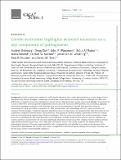Files in this item
Giardia secretome highlights secreted tenascins as a key component of pathogenesis
Item metadata
| dc.contributor.author | Dubourg, Audrey | |
| dc.contributor.author | Xia, Dong | |
| dc.contributor.author | Winpenny, John P | |
| dc.contributor.author | Al Naimi, Suha | |
| dc.contributor.author | Bouzid, Maha | |
| dc.contributor.author | Sexton, Darren W | |
| dc.contributor.author | Wastling, Jonathan M | |
| dc.contributor.author | Hunter, Paul R | |
| dc.contributor.author | Tyler, Kevin M | |
| dc.date.accessioned | 2020-07-29T16:30:01Z | |
| dc.date.available | 2020-07-29T16:30:01Z | |
| dc.date.issued | 2018-03 | |
| dc.identifier | 268917211 | |
| dc.identifier | 52053b4c-34fc-4efd-933b-ac111f56b1be | |
| dc.identifier | 29385462 | |
| dc.identifier | 85050726583 | |
| dc.identifier.citation | Dubourg , A , Xia , D , Winpenny , J P , Al Naimi , S , Bouzid , M , Sexton , D W , Wastling , J M , Hunter , P R & Tyler , K M 2018 , ' Giardia secretome highlights secreted tenascins as a key component of pathogenesis ' , GigaScience , vol. 7 , no. 3 , giy003 . https://doi.org/10.1093/gigascience/giy003 | en |
| dc.identifier.issn | 2047-217X | |
| dc.identifier.other | PubMedCentral: PMC5887430 | |
| dc.identifier.uri | https://hdl.handle.net/10023/20368 | |
| dc.description.abstract | Background: Giardia is a protozoan parasite of public health relevance that causes gastroenteritis in a wide range of hosts. Two genetically distinct lineages (assemblages A and B) are responsible for the human disease. Although it is clear that differences in virulence occur, the pathogenesis and virulence of Giardia remain poorly understood. Results: The genome of Giardia is believed to contain open reading frames that could encode as many as 6000 proteins. By successfully applying quantitative proteomic analyses to the whole parasite and to the supernatants derived from parasite culture of assemblages A and B, we confirm expression of ∼1600 proteins from each assemblage, the vast majority of which are common to both lineages. To look for signature enrichment of secreted proteins, we considered the ratio of proteins in the supernatant compared with the pellet, which defined a small group of enriched proteins, putatively secreted at a steady state by cultured growing trophozoites of both assemblages. This secretome is enriched with proteins annotated to have N-terminal signal peptide. The most abundant secreted proteins include known virulence factors such as cathepsin B cysteine proteases and members of a Giardia superfamily of cysteine-rich proteins that comprise variant surface proteins, high-cysteine membrane proteins, and a new class of virulence factors, the Giardia tenascins. We demonstrate that physiological function of human enteric epithelial cells is disrupted by such soluble factors even in the absence of the trophozoites. Conclusions: We are able to propose a straightforward model of Giardia pathogenesis incorporating key roles for the major Giardia-derived soluble mediators. | |
| dc.format.extent | 13 | |
| dc.format.extent | 1624635 | |
| dc.language.iso | eng | |
| dc.relation.ispartof | GigaScience | en |
| dc.subject | Animals | en |
| dc.subject | Cell Lineage/genetics | en |
| dc.subject | Extracellular Matrix Proteins/genetics | en |
| dc.subject | Gastroenteritis/genetics | en |
| dc.subject | Genome/genetics | en |
| dc.subject | Genotype | en |
| dc.subject | Giardia/genetics | en |
| dc.subject | Giardiasis/genetics | en |
| dc.subject | Humans | en |
| dc.subject | Nerve Tissue Proteins/genetics | en |
| dc.subject | Phylogeny | en |
| dc.subject | Proteomics | en |
| dc.subject | Tenascin/genetics | en |
| dc.subject | QH426 Genetics | en |
| dc.subject | QR Microbiology | en |
| dc.subject | RA Public aspects of medicine | en |
| dc.subject | DAS | en |
| dc.subject | SDG 3 - Good Health and Well-being | en |
| dc.subject.lcc | QH426 | en |
| dc.subject.lcc | QR | en |
| dc.subject.lcc | RA | en |
| dc.title | Giardia secretome highlights secreted tenascins as a key component of pathogenesis | en |
| dc.type | Journal article | en |
| dc.contributor.institution | University of St Andrews. School of Medicine | en |
| dc.identifier.doi | 10.1093/gigascience/giy003 | |
| dc.description.status | Peer reviewed | en |
This item appears in the following Collection(s)
Items in the St Andrews Research Repository are protected by copyright, with all rights reserved, unless otherwise indicated.

